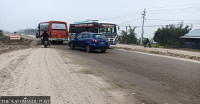National
Miraculous survival at the epicentre
No human deaths even as 1,000 of the 3,500 houses were badly damaged in Barekot.
Prithvi Man Shrestha
Not a single person died from the earthquake at the epicentre of Friday’s quake in Jajarkot even though at least 157 people had been killed in other locations of the district and Rukum West as of Saturday evening.
According to the National Earthquake Monitoring and Research Centre, a 6.4 magnitude earthquake was recorded at Ramidanda village of Barekot Rural Municipality. Despite massive physical damage to the houses and public infrastructure, the rural municipality entirely avoided human causality as of Saturday evening.
“When we see the badly damaged houses, it is difficult to believe how we all cheated death in the area,” said Bir Bahadur Giri, chairperson of the rural municipality. “It is a divine land, and many people believe god saved them.”
According to him, five people in the rural municipality were injured. Of them, two received treatment at the local health office while three were flown to a Surkhet-based hospital.
The rural municipality has around 3,500 houses. “There is hardly any house undamaged by the earthquake. At least 90 percent of them need to be rebuilt while around 1,000 houses have been badly hit and people have been staying in open spaces,” said Giri.
The District Administration Office (DAO), Jajarkot also confirmed that there were no deaths in Barekot Rural Municipality.
According to the details posted by the District Administration Office on Facebook on Saturday evening, as many as 105 people died in the district. Of them, 55 were killed in Nalgaad Municipality, 42 people lost their lives in Bheri Municipality, seven were dead at Kushe Rural Municipality and one at Chhedagad Municipality. The DAO has not reported the death of any person at Barekot Rural Municipality, the epicentre of the devastating earthquake.
Local government chief Giri himself escaped death even as a wall of his house crumbled due to the tremor. “Not only me, many others are sharing similar experiences,” he said.
One reason for the lack of casualties at Ramidanda village could be a sparse settlement. “Nobody was dead [even] in the Silpachaur area nearby that is more densely populated despite massive damage to the houses,” said Dinayat Gharti, chief administrative officer at the rural municipality.
According to experts, the epicentre does not necessarily sustain more physical damage than other locations. “But it is rare and even miraculous for the epicentre to avoid any human causality in a big quake is rare and miraculous,” said Amod Mani Dixit, president of the National Society for Earthquake Technology-Nepal (NSET), an institution formed by Nepali professionals working in the field of disaster risk management.
According to him, the scale of the damage depends on where the fault line is and whether the houses are strong enough to withstand the jolts.




 13.12°C Kathmandu
13.12°C Kathmandu















